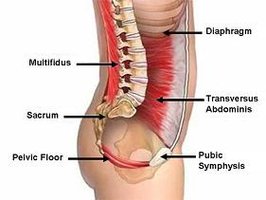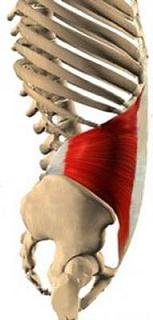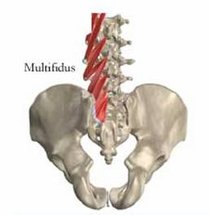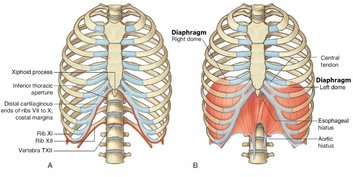16/08/2018 - Albert Sola Renart - Founder of Postural Patterns
Also found described as deep core stability muscles together with the diaphragm, these are:

These muscles and surrounding structures are critical for the spine and the whole body, but so are many other parts of the body when considering posture and whole-body movement.
To group muscles in "core muscles" is pretentious when seeing the body as a whole. The parts are inseparable, tied together, synergistic and every component is having its role in your body. This role also varies depending on the type of movement you are doing, so core muscles may be stabilizing when squatting but may be relaxed when bending down, for example. It all depends on the driver, function and intention. This grouping, classification, is more for the intellectual understanding and comprehension of static structure of the body. Old school? Yes, the structural view of segmenting the body in a sum of parts and pieces, similar to how a car works isn't accurate enough to describe things like pain, symptomatic conditions, pathology, human experience, functional movement and integration. The "deep core muscles" will be a group of muscles I am going to focus on, not for their importance but for the importance of the Layering.
Layering in manual therapy and exercise is quite important and to be mindful and respectful of the layers of the body in any therapy is critical. Some alternative therapies go to very deep layers in the body and come out of them expecting the person to integrate and be empowered. It's not like that in many cases. Just like in high velocity thrusts in chiropractic treatments, the body doesn't have time to integrate the changes and accept fully the new structure. I know well aboutStructural Bodyworkand my Pelvic Health sessions,as manual therapies and training modalities that respect the layers and leave the system gradually empowering the client and making him/her ready for the world. I love working together with
Osteopaths and Chiropractors for a deeper and long lasting fix.
DEEP CORE MUSCLES:
Transversus Abdominis (TrA):
Latin transversus, across, crosswise; abdominis, of the belly/stomach
It is the deepest muscle of the core and acts as a "corset" wrapping the spine and pelvis. The main focus on the Core Stability concept is on the TrA. See the article Core Stability: Myths and Truths
Action: compresses abdomen, helping to support abdominal viscera against pull of gravity.
Basic functional movement: Important during forced expiration, sneezing and coughing. Helps maintain good posture.
Multifidus (MF):
Latin multi, many; findere, to split
These are very short muscles running from the transverse processes (on the sides) of one vertebra up to the spinous process of the next vertebra upwards.
Action: protects vertebral joints from movements produced by the more powerful superficial prime movers. Extension, lateral flexion, and rotation of vertebral column.
Basic functional movement: Helps maintain good posture and spinal stability during standing, sitting and all movement. Prevents flexion, lateral flexion and rotation of vertebral column.


Pelvic Floor (PF) Check article on Pelvic Floor
Diaphragm:
Greek dia, across; phragma, partition, wall
The origin and insertion of this "jellyfish" shaped muscle depends on the moment of the breathing cycle (to master the diaphragm and many main and accessory breathing muscles we highly recommend to take some of our Pelvic Health sessions or a breathwork workshop or course. There is huge importance with the diaphragm. Breath, stress management, mindset and health).

Action: Forms floor of thoracic/pelvic cavity. Pulls its central tendon downward during inhalation, thereby increasing volume of thoracic cavity.
Basic functional movement: Produces about 60% of the breathing capacity.
To be able to work these muscles, deep layers of the body in a non-rigid way is a gift that is highly appreciated for our bodies. We prevent injuries, improving well-being, improving core function, sexual function, breath and enhancing energy levels. In our Pelvic Health sessions we put a lot of emphasis in not training with stiffness or rigid vertebral column. Core Stability exercises are very useful to learn but they don't deliver the promised results in real live when abused of or misused. They have great value, specially when getting acquainted with your body, starting an exercise routine, for instance. Stabilization first, mobility then. Yet don't over stabilize because there the dysfunction starts. Following a dynamic with any form of functional training, core stability exercises are not necessary anymore, as almost any movement that involves the whole body requires the activation of the core. If that remains rigid, problems will occur sooner or later.
Fascial Fitness is right in many things, specially when talking about "creep", when saying that in practical training and life, when tissues are loaded predominantly in 1 way (even if it's the "proper one") creep is created and when it happens that you load tissues in a different way (doing a "wrong" movement), there is high risk of injury and overloading tissues, either concentrically or eccentrically. With that I must say that there is such thing as good posture and good bio-mechanics, but if you are too rigid and never get out of good proper movement, when you get out of it unconsciously, you may overload your system. So there is no need to be too strict with yourself and train your body to be adaptable, not rigid.
Thursday: 09:00–19:30
Friday: 09:00–19:30
Saturday: 09:00–19:30
Sunday: 09:00–19:30
Overtoom 570
1054LN Amsterdam